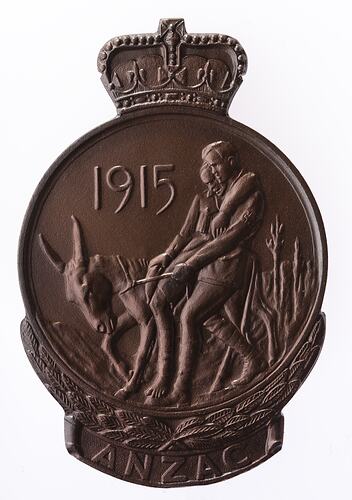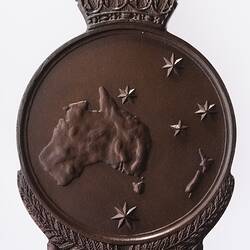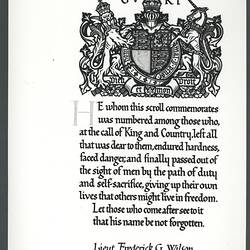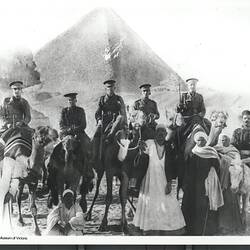Summary
Anzac commemorative medallion (in case) presented to the family of Lieutenant Frederick Gladstone Wilson in 1967 to mark the 50th anniversary of the Gallipoli campaign. Wilson was born on 15 August 1890 and was a commercial traveller when he enlisted on 19 October 1914, aged 24. (His father was a locomotive driver with the Victorian Railways.) Wilson was made an officer in the 13th Battalion, AIF on the basis of his previous military experience with the 10th Australian Light Horse; he had also passed as a lieutenant and captain in the 19th Battalion in 1913. He is depicted sightseeing in Egypt a photograph held in the Australian War Memorial (P05382.006). Wilson's 13th Battalion landed at Gallipoli under heavy fire late in the afternoon of 25 April 1915, part of the 4th Brigade under the command of Colonel John Monash. Wilson was killed the next day. He was buried near Quinn's Post during an armistice on 24 May. His body was never found again, and he is commemorated on a plaque at Courtney's and Steel's Post Cemetery, near Anzac Cove. An obiturary described him as 'smart in appearance and manner, and possessed of a genial disposition, he was a favorite with his brother officers and those under him'. (Daily Telegraph, 6 May 1915, page 7)
Frederick's brother Gilbert Glenloth Wilson also served and died in World War I. Born about 1893, he was an engine cleaner with the Victorian Railways when he enlisted on 18 January 1915, aged 22 (service no. 545). He landed at Gallipoli on 29 August 1915, four months after his brother Frederick was killed there. Corporal Wilson, serving in the 2nd Pioneer Battalion, was killed in France on 14 November 1916. A photograph of him is held in the Australian War Memorial collection (P08024.001). Frederick and Gilbert's father had also lost his wife Eleanor (Cater) in 1906, at the age of 37.
In March 1967 the Prime Minister, the Rt. Hon. Harold Holt, announced that a commemorative medallion and badge was to be issued to surviving members of the Australian Defence Force who served on the Gallipoli Peninsula, or in direct support of the operations from close off shore, at any time during the period from the first Anzac Day in April 1915 to the date of final evacuation in January 1916. The medal was designed by Eric Garrett, Department of the Army, and depicts John Simpson Kirkpatrick and his donkey rescuing the wounded.
Physical Description
A circular bronze medal with crown at top and wreath and plaque at base in box of issue. The obverse featured Simpson and his donkey carrying a wounded soldier to safety; in the field above, 1915; the wreath below is laurel and the plaque carries the word, ANZAC. The reverse depicts a relief map of Australia and New Zealand with the Southern Cross superimposed; the wreath below is a New Zealand Fern and the plaque is engraved F. G. WILSON Medal housed in case with certificate.
Obverse Description
A circular bronze medal with crown at top and wreath and plaque at base. At centre, Simpson and his donkey carrying a wounded soldier to safety; in the field above, 1915; the wreath below is laurel and the plaque carries the word, ANZAC.
Reverse Description
A circular bronze medal with crown at top and wreath and plaque at base. A relief map of Australia and New Zealand with the Southern Cross superimposed; the wreath below is a New Zealand Fern and the plaque is engraved F. G. WILSON
Edge Description
Plain
Significance
A commemorative medallion and badge was to be issued to surviving members of the Australian Defence Force who served on the Gallipoli Peninsula, or in direct support of the operations from close off shore, at any time during the period from the first Anzac Day in April 1915 to the date of final evacuation in January 1916.
More Information
-
Collecting Areas
-
Acquisition Information
Donation from Mr Anthony Kenneth Bonica, 20 May 1985
-
Date Issued
1967 AD
-
Issued By
-
Artist
-
Designer
-
Awarded To
-
Place
Gallipoli Peninsula, Turkey, 1915
Place & date commemorated -
Inscriptions
F. G. WILSON 1915 ANZAC
-
Material
Bronze
-
Axis
12
-
Classification
-
Category
-
Discipline
-
Type of item
-
Overall Dimensions
50 mm (Width), 75 mm (Height)
Box 82 x 95 mm black
-
Shape
Round with crown at top
-
References
Australian War Memorial website; [Link 1] 1915 'Lieut. Frederick Gladstone Wilson', The Sun (Sydney, NSW : 1910 - 1954), 7 May, p. 4. (FINAL EXTRA), viewed 12 Apr 2021, [Link 2] 1915 'WHO THEY WERE.', The Sun (Sydney, NSW : 1910 - 1954), 5 May, p. 5. (FINAL RACING), viewed 12 Apr 2021, [Link 3] 1915 'LIEUTENANT WILSON.', The Daily Telegraph (Sydney, NSW : 1883 - 1930), 6 May, p. 7. , viewed 12 Apr 2021, [Link 4] '13th Australian Infantry Battalion ', Australian War Memorial, [Link 5] accessed 12/4/2021. 1906 'Family Notices', Gippsland Times (Vic. : 1861 - 1954), 23 April, p. 2. (MORNINGS.), viewed 14 Apr 2021, [Link 6] 'Gallipoli Peninsula, Turkey. 24 May 1915. Australian burial parties burying Australian...', Australian War Memorial [Link 7] accessed 19/4/2021. (Lieutenant Wilson was buried on this day, almost four weeks after he was killed.)
-
Keywords
Anzac Day, Commemorations, Wars & Conflicts, World War I, 1914-1918






